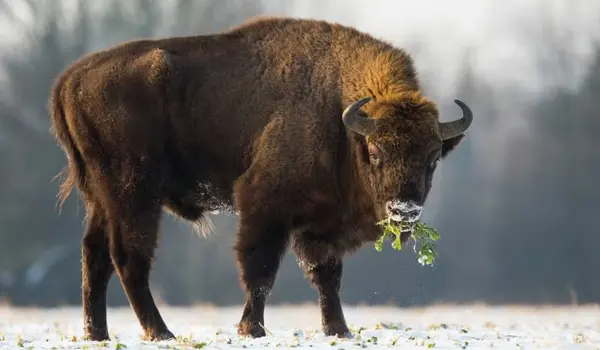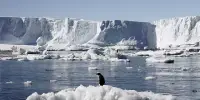Simulations use historical records, fossils, and ancient DNA to explain why the European bison nearly went extinct and to identify appropriate conservation sites. Since the near-extinction of the European bison, massive conservation efforts have helped to rebuild wild populations, and their numbers are increasing. The study’s authors, however, suggest that knowing why the species nearly went extinct in the first place is critical to guaranteeing their long-term conservation and recovery.
“Our study also suggests areas where rewilding efforts are most likely to be successful,” said main author July Pilowsky, who is currently a disease ecologist at Cary Institute of Ecosystem Studies. Pilowsky did the research while pursuing their PhD at the University of Adelaide and the University of Copenhagen.
At the end of the last ice age, enormous bison herds inhabited Europe. However, by 1927, the European bison had become extinct in the wild, with just approximately 60 individuals left in captivity. Scientists have long argued the precise causes of the grazers’ near-extinction, as well as the extent to which people were responsible.
A new study uses fossil evidence, ancient DNA, and modeling to unravel the stressors that drove the European bison population down. The study, published today in the journal Proceedings of the Royal Society B: Biological Sciences, found that rapid environmental change and human hunting were the primary drivers.
Since the near-extinction of the European bison, enormous conservation efforts have helped to restore wild populations, and its numbers are on the rise. However, the study authors argue that ensuring the species’s long-term protection and recovery requires understanding why they nearly went extinct in the first place.
This study is one of the few attempts to reconstruct the process of species extinction. It is a fascinating story of a species that is the last remnant of the legendary megafauna that inhabited the European continent in the late Pleistocene, and a lesson in how easy it is to wipe out a species.
Rafał Kowalczyk
Reconstructing the bison’s decline
“This study is one of the few attempts to reconstruct the process of species extinction,” said co-author Rafał Kowalczyk, who heads the Mammal Research Institute at the Polish Academy of Sciences. “It is a fascinating story of a species that is the last remnant of the legendary megafauna that inhabited the European continent in the late Pleistocene, and a lesson in how easy it is to wipe out a species.”
Pilowsky and colleagues created a detailed simulation to determine which factors contributed to the European bison’s decline, combining paleoclimate data, vegetation and habitat information, Palaeolithic human population growth and expansion across Eurasia, and bison population and dispersal dynamics. Historical records, fossil evidence, and ancient DNA were utilized to independently assess the model’s correctness.
Researchers ran 55,000 different simulations to explore how climate, hunting by humans, and land use change affected bison population and distribution across Europe. Toggling off different variables one at a time allowed the scientists to test the importance of each variable. If human removal of forests was turned down to zero, for example, and there was no change in bison abundance and range, then the scientists would conclude that land use change likely was not a factor in the species’ demise.
After reconstructing 21,000 years of European bison range dynamics, the team concluded that the bison’s range began collapsing around 14,700 years ago due to rapid warming of the climate and its effects on bison habitat. After that, the activities of a growing number of humans prevented the bison from bouncing back. Hunting caused range loss in the north and east of its distribution, while land use change was responsible for losses in the west and south. The arrival of firearms in the 1500s dramatically hastened the species’s decline.

“The stories of the past are being repeated in the present,” said Kowalczyk. Land use change, poaching, and climate change are the very same threats that imperil the European bison today. “Learning from the past, and understanding the process of species extinction, can help us better protect the species.”
Maximizing conservation efforts
The European bison is a priority species for conservation because it serves an important role as an ecosystem engineer, restoring grassland habitat. Thanks to efforts to reestablish and rewild the species, there are approximately 7,300 free-ranging European bison today. However, rewilding has been done without a strong understanding of habitats and regions where bison once thrived. As a result, the species has been released at sites ranging from the coastal dunes of the Netherlands to the mountains of the French Alps and the Mediterranean climate of Spain, with mixed success. Of the 47 free-living European bison populations, only eight have more than 150 adults, and all eight depend on supplemental feeding due to poor habitat suitability.
By determining places where European bison would be distributed today if hunting and land use change had not occurred, the study focuses on regions most favorable for the species’ restoration. These include portions of Poland, Ukraine, and western Russia.
With habitat restoration, portions of the Balkans and Germany have the potential to be ideal sites for bison reintroduction.
“I hope that the maps we’ve produced can help inform future efforts in terms of where reintroduction efforts should occur,” Pilowsky said. “It’s especially important because of the conflict in Ukraine. Conservationists are deeply concerned since Ukraine is home to more than half of all free-living bison.
Next steps
Pilowsky next hopes to adjust the simulations to identify sites that are not only suitable for European bison today, but also in the future under human-caused climate and environmental change.
The study’s methods could potentially be used to reconstruct the reasons of population decreases and range collapses in other great herbivores, such as American bison, in order to raise awareness of previous dangers and inform current conservation initiatives.
Pilowsky’s new fields of inquiry are informed by the lessons learned. The Cary Institute is turning the bison simulation code into new software that simulates illness spread in wildlife. “I literally have my bison code open on one monitor and my new code that I’m building on another monitor,” they went on to say. Instead of replicating bison abundance and range, the new software depicts the prevalence and dispersion of a disease within a species across time.
















